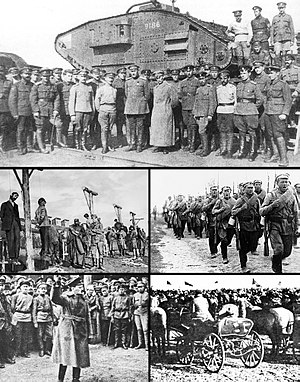Hallanic Wars
| Hallanic Wars | |||||||
|---|---|---|---|---|---|---|---|
 | |||||||
| |||||||
| Belligerents | |||||||
|
Until December 1916 |
Until December 1916 | ||||||
|
1916 - 1917 |
1916 - 1917 Other factions | ||||||
|
April 1917 - March 1918 |
April 1917 - March 1918 | ||||||
The Hallanic Wars (Tuskish: De hallaniske krige), were a series of separate but related ethnic conflicts and wars of independence fought in the territories of the Kingdom of Hallania after its defeat in the Continental War. The conflicts lasted from 1916 to 1918, and resulted in the breakup of the Kingdom of Hallania. The conflicts were largely organised along ethnic lines, with the former constituent kingdoms declaring independence and separatists beginning insurgencies.
The first revolt began in 1913 with the start of the Fourth Crethian Uprising. While the initial revolt was suppressed, Crethian nationalists and anti-monarchists organized a continued insurgency. As Hallania faced defeat in the Continental War, tensions in the other constituent realms grew. The Green Movement was formed in May 1916 by separatists throughout the kingdom, starting a coordinated effort to secure independence from Hallania. While initially the Royal Hallanic Army sought to preserve the unity of the Kingdom of Hallania, it came under increasing influence of the Tuskish-dominated royal government as the conflict worsened, with the separatists beginning to make significant gains.
With the dissolution of the kingdom becoming more and more of a certainty, the Royal Army's focus shifted from the preservation of Hallanian integrity to the "lesser solution" of the establishment of a "Greater Tuskval" based on its pre-unification borders. This alienated non-Tuskes, causing the Royal Army to lose the support of its ethnic Crethians, Svaldish, and Velskish supporters, transforming it from a pan-Hallanic force to a predominantly Tuskish army bolstered by loyalists forces, notably in Velsken. While there were dozens of belligerents on the separatist side throughout the conflict, by April 1917, only the Crethian Free State, the Republic of Svaldheim, and the Republic of Velsken remained against the royal government.
The Hallanic Wars ended in (some date) 1918 following the Some City Accords, resulting in the independence of Crethia, Svaldheim, and Tuskval. The peace would prove itself to be unstable, with issues left unresolved by the Accords, most notably the status of Velsken and the continuing insurgency, as well as the delimitation of the Svaldish-Tuskish border, led to the eruption of the Second Hallanic Wars a decade later.
The wars came with a massive human cost and resulted in severe economic damage to the archipelago. Overtime, post-wars tensions eased and cooperation between the countries of Hallania would culminate in the formation of Hallanic Commonwealth in 1956, marking a formal end to wars on the archipelago.